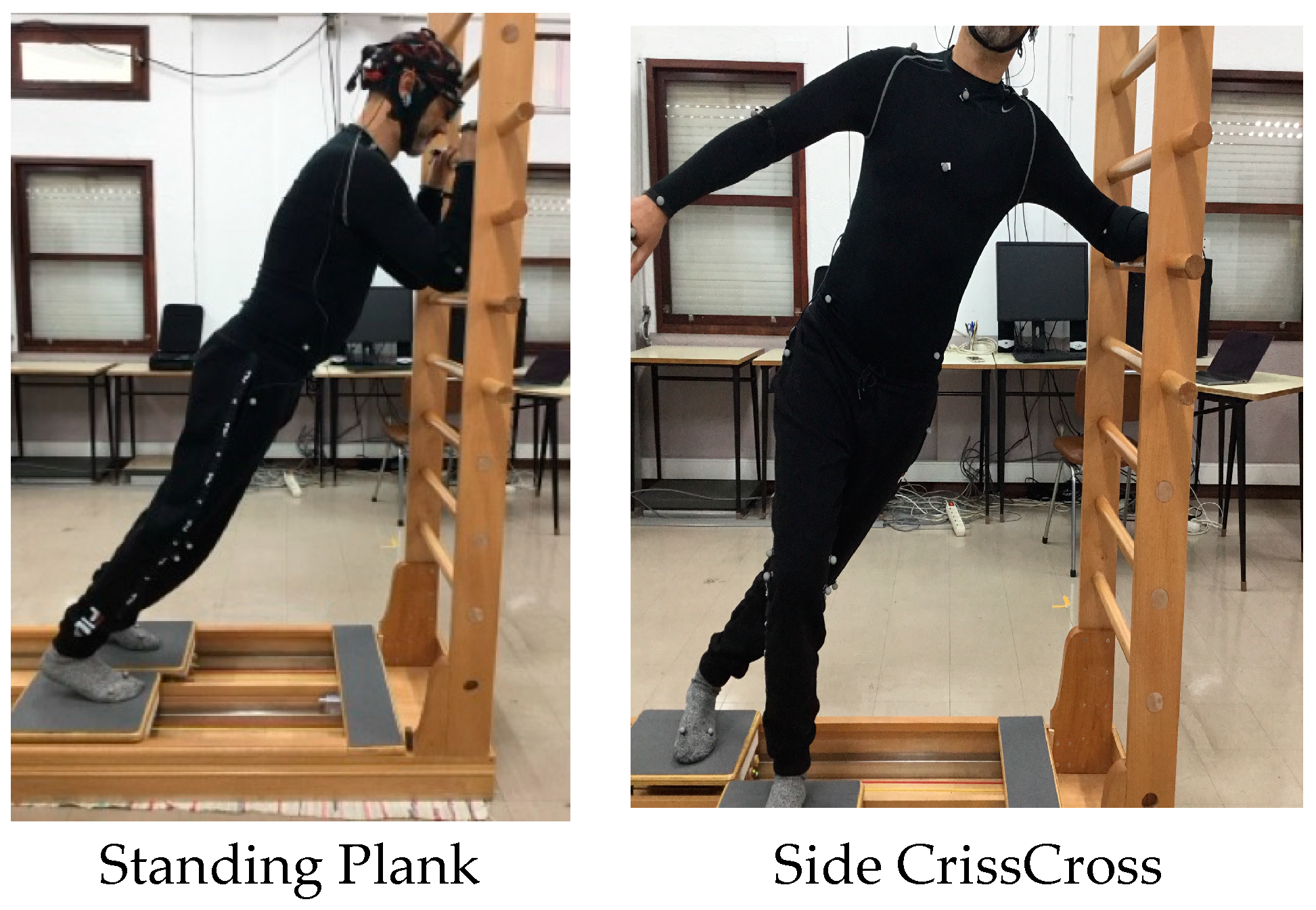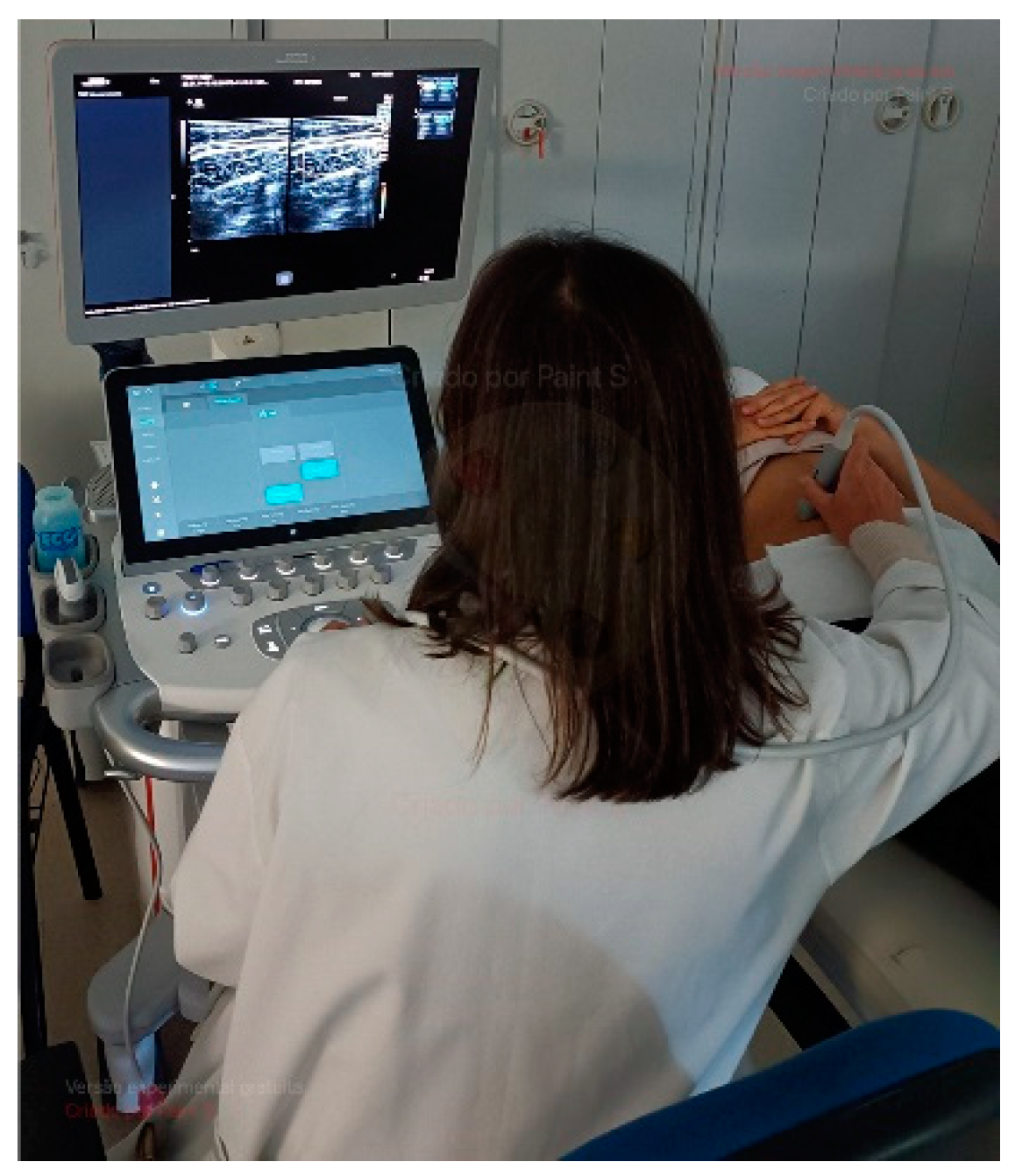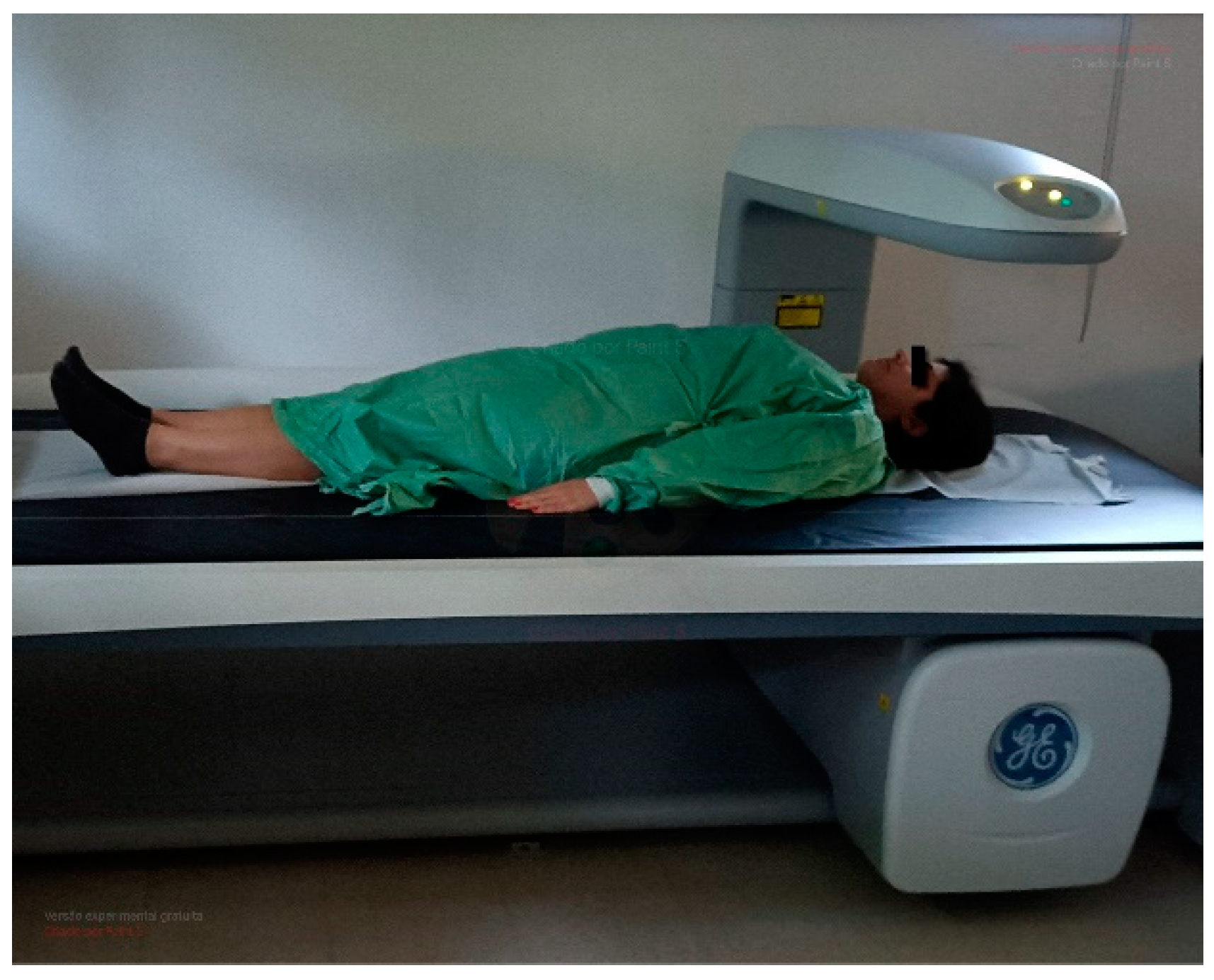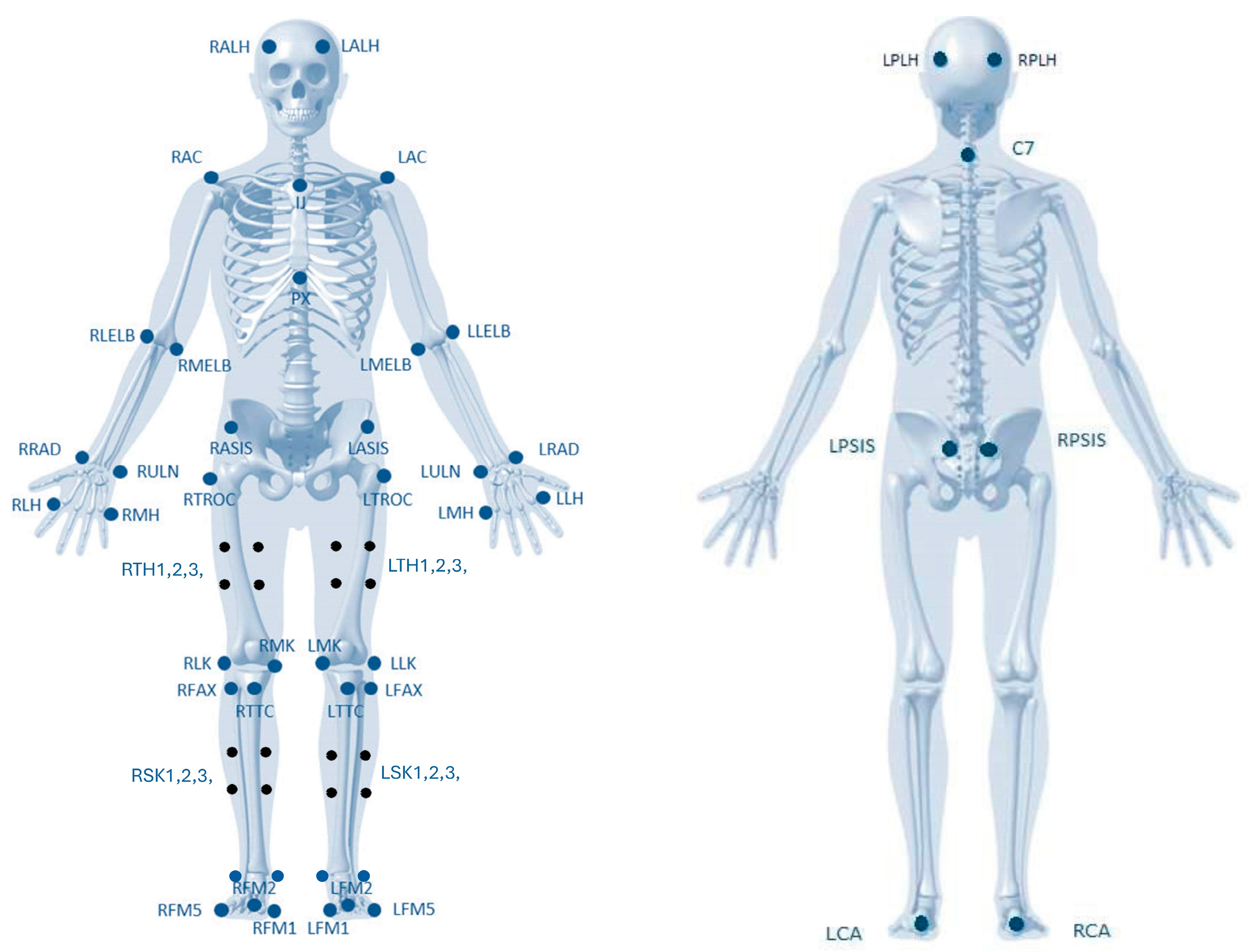Methodology and Experimental Protocol for Studying Learning and Motor Control in Neuromuscular Structures in Pilates
Abstract
1. Introduction
2. Materials and Methods
2.1. Study Settings and Design
2.2. Sample
Eligibility Criteria
2.3. Intervention
2.4. Outcomes
2.4.1. Abdominal Wall Muscle Ultrasound (AWMUS)
2.4.2. Shear Wave Elastography (SWE) Assessment
2.4.3. Body Composition Analysis
2.4.4. Gaze Behavior Assessment
2.4.5. Electroencephalography (EEG)
2.4.6. Video Motion
2.4.7. Qualitative Research
2.5. Operationalization/Sequence
2.6. Statistical Analyses
2.7. Timetable
3. Results
4. Conclusions
5. Patents
Author Contributions
Funding
Institutional Review Board Statement
Informed Consent Statement
Data Availability Statement
Acknowledgments
Conflicts of Interest
Appendix A

Appendix B
| Exercise | Time Distribution | ||
|---|---|---|---|
| 1–4 Week | 5–6 Week | 7–8 Week | |
| Standing Leg Pump (Chair) | √ | √ | √ |
| Front and Oblique Reverse Abdominals (Reformer) | √ | √ | √ (added yellow spring) |
| Bridging (Mat) | -- | √ | √ |
| Footwork (Reformer) | √ | √ | √ |
| Side Sit Up (Ladder Barrel) | √ | √ | √ |
| Adapted Leg Pull Front (Mat) | √ | √ | √ |
| Rolldown Series (Cadillac) | √ (small yellow springs) | √ (long yellow springs) | √ (long yellow springs) |
| Standing Plank (Standing Machine) (8 rep 2 series at first lap of circuit) | √ | √ | √ |
| Side Criss Cross (Standing Machine) (8 rep 2 series at second lap of circuit) | √ | √ | √ |
Appendix C
| Researcher | Action | |||||||
|---|---|---|---|---|---|---|---|---|
| A | 1 | Greeting and Welcoming/Informed Consent | ||||||
| C | 2 | Ultrasound 1 (at rest) | ||||||
| B | A | 3 | Equip the subject with the apparatus for the study | EEG | ||||
| Video Motion | ||||||||
| Tobii | ||||||||
| B | Mirror Protects the massage table | |||||||
| A | 4 | Calibration | EEG (RELAX- Eyes open/Eyes closed) | |||||
| Tobii | ||||||||
| A | 5 | Video viewing 1 | ||||||
| B | Front Mirror Machine | |||||||
| C | B | 6 | Ultrasound 2 during exercise 1 Standing plank: ACTION! | |||||
| A | 7 | Video viewing 2 | ||||||
| B | 8 | Side Mirror (LEFT) of the Machine | ||||||
| B | 9 | ACTION—exercise 2—Side Criss Cross | ||||||
| B | 10 | Unequip the participant (thank you message) | ||||||
| Batterie | EEG | |||||||
| 11 | Equipment check | Tobii | ||||||
| A | SD Card | Tobii | ||||||
| Researcher | Action | |||||||
|---|---|---|---|---|---|---|---|---|
| A | 1 | Reception/Free and Informed Consent | ||||||
| C | 2 | Ultrasound 1 (at rest) | ||||||
| B | A | 3 | Equip the subject with the apparatus for the study | EEG | ||||
| Video Motion | ||||||||
| Tobii | ||||||||
| B | Mirror Protects the massage table | |||||||
| A | 4 | Calibration | EEG (RELAX- Eyes open/Eyes closed) | |||||
| Tobii | ||||||||
| A | 5 | Video viewing 1 | ||||||
| B | Front Mirror Machine | |||||||
| C | B | 6 | Ultrasound 2 during exercise 1 Standing plank: ACTION! | |||||
| A | 7 | Video viewing 2 | ||||||
| B | 8 | Side Mirror (RIGHT) of the Machine | ||||||
| B | 9 | ACTION—exercise 2—Side Criss Cross | ||||||
| B | 10 | Move the machine side mirror (LEFT) | ||||||
| B | 11 | Unequip the participant (thank you message) | ||||||
| Batteries | EEG | |||||||
| 12 | Equipment check | Tobii | ||||||
| A | SD Card | Tobii | ||||||
References
- Wells, C.; Kolt, G.S.; Bialocerkowski, A. Defining Pilates exercise: A systematic review. Complement. Ther. Med. 2012, 20, 253–262. [Google Scholar] [CrossRef]
- Fernández-Rodríguez, R.; Álvarez-Bueno, C.; Ferri-Morales, A.; Torres-Costoso, A.; Pozuelo-Carrascosa, D.P.; Martínez-Vizcaíno, V. Pilates improves physical performance and decreases risk of falls in older adults: A systematic review and meta-analysis. Physiotherapy 2021, 112, 163–177. [Google Scholar] [CrossRef]
- Lim, H.S.; Kim, Y.L.; Lee, S.M. The effects of Pilates exercise training on static and dynamic balance in chronic stroke patients- a randomized controlled trial. J. Phys. Ther. Sci. 2016, 28, 1819–1824. [Google Scholar] [CrossRef]
- Pereira, M.J.; Mendes, R.; Mendes, R.S.; Martins, F.; Gomes, R.; Gama, J.; Dias, G.; Castro, M.A. Benefits of Pilates in the Elderly Population: A Systematic Review and Meta-Analysis. Eur. J. Investig. Health Psychol. Educ. 2022, 12, 236–268. [Google Scholar] [CrossRef]
- Araujo, D.; Davids, K.; Chow, J.; Passos, P. The Development of Decision Making Skill in Sport—An Ecological Dynamics Perspective; Raab, M., Araujo, D., Ripoll, H., Eds.; Nova Science Publishers Inc.: New York, NY, USA, 2009. [Google Scholar]
- Dias, G. Coordenação e controlo de movimentos musicais e desportivos: Visão dinâmica da cognição e ação. Per Musi 2015, 32, 97–113. [Google Scholar] [CrossRef]
- Pereira, M.J.; Dias, G.; Mendes, R.; Martins, F.; Gomes, R.; Castro, M.A.; Vaz, V. Movement variability in Pilates: A scoping review. Front. Psychol. 2023, 14, 1195055. [Google Scholar] [CrossRef]
- Xu, M.; Tian, C.; Wang, Y.; Liang, S.; Wang, Y.; Li, X.; Yang, K. Pilates and multiple health outcomes: An umbrella review. J. Sci. Med. Sport 2023, 26, 232–240. [Google Scholar] [CrossRef]
- Batıbay, S.; Külcü, D.G.; Kaleoğlu, Ö.; Mesci, N. Effect of Pilates mat exercise and home exercise programs on pain, functional level, and core muscle thickness in women with chronic low back pain. J. Orthop. Sci. 2021, 26, 979–985. [Google Scholar] [CrossRef]
- Endleman, I.; Critchley, D.J. Transversus Abdominis and Obliquus Internus Activity During Pilates Exercises: Measurement with Ultrasound Scanning. Arch. Phys. Med. Rehabil. 2008, 89, 2205–2212. [Google Scholar] [CrossRef]
- Goldberg, N.; Weisman, A.; Schuster, S.; Dar, G.; Masharawi, Y. Effect of a full pilates group exercise program on transversus abdominis thickness, daily function and pain in women with chronic low back pain. Kinesiology 2021, 53, 318–325. [Google Scholar] [CrossRef]
- Ebenbichler, G.R.; Oddsson, L.I.; Kollmitzer, J.; Erim, Z. Sensory-motor control of the lower back: Implications for rehabilitation. Med. Sci. Sports Exerc. 2001, 33, 1889–1898. [Google Scholar] [CrossRef]
- Hirayama, K.; Akagi, R.; Moniwa, Y.; Okada, J.; Takahashi, H. Transversus abdominis elasticity during various exercises: A shear wave ultrasound elastography study. Int. J. Sports Phys. Ther. 2017, 12, 601–606. [Google Scholar]
- Ismail, L.; Karwowski, W.; Hancock, P.A.; Taiar, R.; Fernandez-Sumano, R. Electroencephalography (EEG) Physiological Indices Reflecting Human Physical Performance: A Systematic Review Using Updated PRISMA. J. Integr. Neurosci. 2023, 22, 62. [Google Scholar] [CrossRef]
- Rodriguez-Bermudez, G.; Garcia-Laencina, P.J. Analysis of EEG Signals using Nonlinear Dynamics and Chaos—A review. Appl. Math. Inf. Sci. 2015, 9, 2309–2321. [Google Scholar] [CrossRef]
- Scharfen, H.; Memmert, D. Measurement of cognitive functions in experts and elite athletes: A meta-analytic review. Appl. Cogn. Psychol. 2019, 33, 843–860. [Google Scholar] [CrossRef]
- Bessa, N.P.O.S.; Filho, B.F.d.L.; de Medeiros, C.S.P.; Ribeiro, T.S.; Campos, T.F.; Cavalcanti, F.A.d.C. Effects of exergames training on postural balance in patients who had a chronic stroke: Study protocol for a randomised controlled trial. BMJ Open 2020, 10, e038593. [Google Scholar] [CrossRef]
- Lin, W.; Chen, Q.; Jiang, M.; Tao, J.; Liu, Z.; Zhang, X.; Wu, L.; Xu, S.; Kang, Y.; Zeng, Q. Sitting or Walking? Analyzing the Neural Emotional Indicators of Urban Green Space Behavior with Mobile EEG. J. Urban Health 2020, 97, 191–203. [Google Scholar] [CrossRef]
- Williams, N.S.; McArthur, G.M.; de Wit, B.; Ibrahim, G.; Badcock, N.A. A validation of Emotiv EPOC Flex saline for EEG and ERP research. PeerJ 2020, 8, e9713. [Google Scholar] [CrossRef]
- Lynch, J.A.; Chalmers, G.R.; Knutzen, K.M.; Martin, L.T. Effect on performance of learning a pilates skill with or without a mirror. J. Bodyw. Mov. Ther. 2009, 13, 283–290. [Google Scholar] [CrossRef]
- Montuori, S.; Curcio, G.; Sorrentino, P.; Belloni, L.; Sorrentino, G.; Foti, F.; Mandolesi, L. Functional Role of Internal and External Visual Imagery: Preliminary Evidences from Pilates. Neural Plast. 2018, 2018, 7235872. [Google Scholar] [CrossRef]
- Yao, W.X.; Ge, S.; Zhang, J.Q.; Hemmat, P.; Jiang, B.Y.; Liu, X.J.; Lu, X.; Yaghi, Z.; Yue, G.H. Bilateral transfer of motor performance as a function of motor imagery training: A systematic review and meta-analysis. Front. Psychol. 2023, 14, 1187175. [Google Scholar] [CrossRef]
- Miller, H.N.; Rice, P.E.; Felpel, Z.J.; Stirling, A.M.; Bengtson, E.N.; Needle, A.R. Influence of Mirror Feedback and Ankle Joint Laxity on Dynamic Balance in Trained Ballet Dancers. J. Dance Med. Sci. 2018, 22, 184–191. [Google Scholar] [CrossRef]
- Rabin, A.; Einstein, O.; Kozol, Z. The association of visually-assessed quality of movement during jump-landing with ankle dorsiflexion range-of-motion and hip abductor muscle strength among healthy female athletes. Phys. Ther. Sport 2018, 31, 35–41. [Google Scholar] [CrossRef]
- Campbell, D.T.; Stanley, J.C. Experimental and Quasi-Experimental Designs for Research; Houghton Mifflin Company: Palo Alto, CA, USA; Boston, MA, USA; London, UK, 1959. [Google Scholar]
- Han, H.; Chen, S.; Wang, X.; Jin, J.; Li, X.; Li, Z. Association between muscle strength and mass and bone mineral density in the US general population: Data from NHANES 1999–2002. J. Orthop. Surg. Res. 2023, 18, 397. [Google Scholar] [CrossRef]
- Barbosa, A.C.; Vieira, E.R.; Silva, A.F.; Coelho, A.C.; Martins, F.M.; Fonseca, D.S.; Barbosa, M.A.; Bordachar, D. Pilates experience vs. muscle activation during abdominal drawing-in maneuver. J. Bodyw. Mov. Ther. 2018, 22, 467–470. [Google Scholar] [CrossRef]
- Yentür, S.B.; Ataş, N.; Öztürk, M.A.; Oskay, D. Comparison of the effectiveness of pilates exercises, aerobic exercises, and pilates with aerobic exercises in patients with rheumatoid arthritis. Ir. J. Med Sci. 2021, 190, 1027–1034. [Google Scholar] [CrossRef]
- Lee, K. The Relationship of Trunk Muscle Activation and Core Stability: A Biomechanical Analysis of Pilates-Based Stabilization Exercise. Int. J. Environ. Res. Public Health 2021, 18, 12804. [Google Scholar] [CrossRef]
- Tahan, N.; Khademi-Kalantari, K.; Mohseni-Bandpei, M.A.; Mikaili, S.; Baghban, A.A.; Jaberzadeh, S. Measurement of superficial and deep abdominal muscle thickness: An ultrasonography study. J. Physiol. Anthr. 2016, 35, 17. [Google Scholar] [CrossRef]
- Siqueira, G.R.; Alencar, G.G.; Oliveira, É.M.; Teixeira, V.Q. Efeito do pilates sobre a flexibilidade do tronco e as medidas ultrassonográficas dos músculos abdominais. Rev. Bras. Med. Esporte 2015, 21, 139–143. [Google Scholar] [CrossRef][Green Version]
- Koppenhaver, S.L.; Hebert, J.J.; Parent, E.C.; Fritz, J.M. Rehabilitative ultrasound imaging is a valid measure of trunk muscle size and activation during most isometric sub-maximal contractions: A systematic review. Aust. J. Physiother. 2009, 55, 153–169. [Google Scholar] [CrossRef]
- Eby, S.F.; Song, P.; Chen, S.; Chen, Q.; Greenleaf, J.F.; An, K.-N. Validation of shear wave elastography in skeletal muscle. J. Biomech. 2013, 46, 2381–2387. [Google Scholar] [CrossRef]
- Morin, M.; Salomoni, S.E.; Stafford, R.E.; Hall, L.M.; Hodges, P.W. Validation of shear wave elastography as a noninvasive measure of pelvic floor muscle stiffness. Neurourol. Urodyn. 2022, 41, 1620–1628. [Google Scholar] [CrossRef]
- Marouvo, J.; Sousa, F.; André, M.A.; Castro, M.A. Tibialis posterior muscle stiffness assessment in flat foot subjects by ultrasound based Shear-Wave Elastography. Foot 2023, 54, 101975. [Google Scholar] [CrossRef]
- Bercoff, J.; Tanter, M.; Fink, M. Supersonic shear imaging: A new technique for soft tissue elasticity mapping. IEEE Trans. Ultrason. Ferroelectr. Freq. Control 2004, 51, 396–409. [Google Scholar] [CrossRef]
- Koppenhaver, S.; Kniss, J.; Lilley, D.; Oates, M.; Fernández-De-Las-Peñas, C.; Maher, R.; Croy, T.; Shinohara, M. Reliability of ultrasound shear-wave elastography in assessing low back musculature elasticity in asymptomatic individuals. J. Electromyogr. Kinesiol. 2018, 39, 49–57. [Google Scholar] [CrossRef]
- Akagi, R.; Takahashi, H. Acute Effect of Static Stretching on Hardness of the Gastrocnemius Muscle. Med. Sci. Sports Exerc. 2013, 45, 1348–1354. [Google Scholar] [CrossRef]
- Ramos, R.L.; Armán, J.A.; Galeano, N.A.; Hernández, A.M.; Gómez, J.G.; Molinero, J.G. Dual energy X-ray absorptiometry—Fundamentals, methodology, and clinical applications. Radiología 2012, 54, 410–423. [Google Scholar]
- Formica, C.; Baldwin, K.M.; Joanisse, D.R.; Haddad, F.; Goldsmith, R.L.; Gallagher, D.; Pavlovich, K.H.; Shamoon, E.L.; Leibel, R.L.; Rosenbaum, M.; et al. Dual-energy X-ray absorptiometry body composition model: Review of physical concepts. Am. J. Physiol. Metab. 1996, 271, E941–E951. [Google Scholar] [CrossRef]
- Bazzocchi, A.; Ponti, F.; Albisinni, U.; Battista, G.; Guglielmi, G. DXA: Technical aspects and application. Eur. J. Radiol. 2016, 85, 1481–1492. [Google Scholar] [CrossRef]
- Thomas, S.R.; Kalkwarf, H.J.; Buckley, D.D.; Heubi, J.E. Effective Dose of Dual-Energy X-Ray Absorptiometry Scans in Children as a Function of Age. J. Clin. Densitom. 2005, 8, 415–422. [Google Scholar] [CrossRef]
- Seabra, A.F.; Brito, J.; Krustrup, P.; Hansen, P.R.; Mota, J.; Rebelo, A.; Rêgo, C.; Malina, R.M. Effects of a 5-month football program on perceived psychological status and body composition of overweight boys. Scand. J. Med. Sci. Sports 2014, 24, 10–16. [Google Scholar] [CrossRef]
- Wittich, A.; Oliveri, M.B.; Rotemberg, E.; Mautalen, C. Body Composition of Professional Football (Soccer) Players Determined by Dual X-Ray Absorptiometry. J. Clin. Densitom. 2001, 4, 51–55. [Google Scholar] [CrossRef]
- Harley, J.A.; Hind, K.; O’hara, J.P. Three-compartment body composition changes in elite rugby league players during a super league season, measured by dual-energy X-ray absorptiometry. J. Strength Cond. Res. 2011, 25, 1024–1029. [Google Scholar] [CrossRef]
- Roelofs, E.J.; Smith-Ryan, A.E.; Trexler, E.T.; Hirsch, K.R. Seasonal Effects on Body Composition, Muscle Characteristics, and Performance of Collegiate Swimmers and Divers. J. Athl. Train. 2017, 52, 45–50. [Google Scholar] [CrossRef]
- Leahy, S.; O’neill, C.; Sohun, R.; Jakeman, P. A comparison of dual energy X-ray absorptiometry and bioelectrical impedance analysis to measure total and segmental body composition in healthy young adults. Eur. J. Appl. Physiol. 2012, 112, 589–595. [Google Scholar] [CrossRef]
- Wells, J.C.K.; Fewtrell, M.S. Measuring body composition. Arch. Dis. Child. 2006, 91, 612–617. [Google Scholar] [CrossRef]
- Gomes, R.M.M. Visão e Controlo Motor—Influência da Visão no Controlo da Corrida de Trail; University of Coimbra: Coimbra, Portugal, 2019. [Google Scholar]
- Hashemi, A.; Pino, L.J.; Moffat, G.; Mathewson, K.J.; Aimone, C.; Bennett, P.J.; Schmidt, L.A.; Sekuler, A.B. Characterizing Population EEG Dynamics throughout Adulthood. ENeuro 2016, 3, e0275-16.2016. [Google Scholar] [CrossRef]
- Greuel, H.; Herrington, L.; Liu, A.; Jones, R.K. Does the Powers™ strap influence the lower limb biomechanics during running? Gait Posture 2017, 57, 141–146. [Google Scholar] [CrossRef]
- Lee, K. Agreement between 3D Motion Analysis and Tele-Assessment Using a Video Conferencing Application for Telerehabilitation. Healthcare 2021, 9, 1591. [Google Scholar] [CrossRef]
- Creswell, J.W. Understanding mixed methods research. In Qualitative Inquiry and Research Design: Choosing Among Five Approaches; SAGE Publication Inc.: Thousand Oaks, CA, USA, 2007; Volume 11, pp. 1–19. [Google Scholar]
- Lincoln, Y.; Guba, E.G. Naturalistic Inquiry; SAGE Publication, Inc.: Thousand Oaks, CA, USA, 1985. [Google Scholar]
- Patton, M.Q. Qualitative Research & Evaluation Methods, 4th ed.; SAGE Publication, Inc.: Thousand Oaks, CA, USA, 2015. [Google Scholar]
- Tabachnick, B.G.; Fidell, L.S.; Ullman, J.B. Using Multivariate Statistics; Pearson: New York, NY, USA, 2021. [Google Scholar]
- Field, A. Discovering Statistics Using IBM SPSS Statistics, 5th ed.; SAGE Publications: Thousand Oaks, CA, USA, 2018. [Google Scholar]
- Ferguson, C.J. An effect size primer: A guide for clinicians and researchers. Prof. Psychol. Res. Pract. 2009, 40, 532–538. [Google Scholar] [CrossRef]
- Pallant, J. SPSS Survival Manual: A Step by Step Guide to Data Analysis Using IBM SPSS, 7th ed.; Routledge: London, UK, 2020. [Google Scholar]
- Marôco, J. Análise Estatística Com o SPSS Statistics, 3rd ed.; ReportNumber: Lisboa, Portugal, 2021. [Google Scholar]
- Harbourne, R.T.; Stergiou, N. Movement Variability and the Use of Nonlinear Tools: Principles to Guide Physical Therapist Practice. Phys. Ther. 2009, 89, 267–282. [Google Scholar] [CrossRef] [PubMed]
- Luz, J.; Couceiro, M.; Dias, G.; Figueiredo, C.; Mendes, R.; Ferreira, N. Identification of the Putting Signature; ENOC: Dubai, United Arab Emirates, 2011. [Google Scholar]
- Chen, X.; Solomon, I.C.; Chon, K.H. Comparison of the Use of Approximate Entropy and Sample Entropy Applications to Neural Respiratory Signal. In Proceedings of the 2005 IEEE Engineering in Medicine and Biology 27th Annual Conference, Shanghai, China, 1–4 September 2005. [Google Scholar]
- Stergiou, N. Nonlinear Analysis for Human Movement Variability; CRC Press: Boca Raton, FL, USA, 2018. [Google Scholar]
- Aştefănoaei, C.; Creangă, D.; Pretegiani, E.; Optican, L.M.; Rufa, A. Dynamical Complexity Analysis Of Saccadic Eye Movements In Two Different Psychological Conditions. Rom. Rep. Phys. 2014, 66, 1038–1055. [Google Scholar] [PubMed]
- Silva, F.G.M.; Nguyen, Q.T.; Correia, A.F.; Clemente, F.M.; Martins, F.M.L. Ultimate Performance Analysis Tool (uPATO); Springer Science and Business Media LLC: Dordrecht, The Netherlands, 2019; ISBN 0387233067. [Google Scholar]



| Dependent Variables | |||||||
|---|---|---|---|---|---|---|---|
| AWMUS + SWE | EEG | GAZE | QUALI | Video * | |||
| Independent Variables | Level of experience in Pilates | Control group | S1 | S2 | S3 | S4 | - |
| Non-expertise group | |||||||
| Expertise group | |||||||
| Mirror | Mirror image | S1 | S2 | - | S4 | - | |
| No mirror image | |||||||
| DEXA * | - | - | - | - | - | ||
| Topic | Description | Operationalization | |
|---|---|---|---|
| Age | Age range between 30 and 50 years old | No pathologies that make physical practice unfeasible (according to RGPD and DL nº5/2007) | |
| Gender | Gender Balance (approximately 20 males and 20 females) | ||
| Experience level | Expertise | Practitioners who attend Pilates sessions in one of its forms, for more than 6 months with a frequency equal to or greater than two weekly workouts lasting between 45 and 60 min [27] | |
| Non-expert | Practitioners who have never performed Pilates sessions in any of its forms or subjects who have performed Pilates for less than 3 months for more than a year will also be admitted to this group [27]. | ||
| Health condition | Unhealthy subjects will not participate in the study according to Portuguese law. The following will exclude participants from the sample: glaucoma, epilepsy, or pregnancy [27] |
| Muscle | Anatomical Marker |
|---|---|
| RA | Measurements on the right side only Probe: Vertical Zone: 10 cm to the left of the umbilical scar at the midpoint between the iliac crest and the last rib |
| EO | |
| OI | |
| TrA | Measurements on the right side only Probe: Horizontal Zone: At the level of the navel and 2 cm to the right of the mid-axillary line |
| Marker Name | Location |
|---|---|
| RALH | Approximately over the temple and preferably aligned with the lateral commissure of the eye |
| LALH | |
| RPLH | Over the Occipital bone and at the same level as RALH and LALH on the frontal and sagittal plane |
| LPLH | |
| RAC | Acromial edge of the scapula |
| LAC | |
| C7 | 7th Cervical Vertebrae |
| IJ | Jugular Insertion/Notch of the Sternum |
| PX | Xiphoid Process of the Sternum |
| RLELB | Lateral Epicondyle of the Humerus |
| LLELB | |
| RMELB | Medial Epicondyle of the Humerus |
| LMELB | |
| RRAD | Radio-Styloid Process |
| LRAD | |
| RULN | Ulna-Styloid Process |
| LULN | |
| RLH | Lateral portion of the 5th metatarsal head |
| LLH | |
| RMH | Medial portion of the 5th metatarsal head |
| LMH | |
| RASIS | Anterior Superior Iliac Spine |
| LASIS | |
| RPSIS | Posterior Superior Iliac Spine |
| LPSIS | |
| RTROC | Trochanter |
| LTROC | |
| RLK | Lateral Condyle of the Femur |
| LLK | |
| RMK | Medial Condyle of the Femur |
| LMK | |
| RFAX | Proximal tip of the head of the Fibula |
| LFAX | |
| RTTC | Most anterior portion of the Tibia Tuberosity |
| LTTC | |
| RLA | Lateral prominence of the lateral Malleolus |
| LLA | |
| RMA | Medial prominence of the lateral Malleolus |
| LMA | |
| RCA | Distal end of the posterior aspect of the Calcaneus. Should be vertically aligned with FM2. |
| LCA | |
| RFM1 | Lateral aspect of the 1st metatarsal head |
| LFM1 | |
| RFM2 | Dorsal aspect of the 2nd metatarsal head. |
| LFM2 | Calcaneus marker should be vertically aligned. |
| RFM5 | Lateral aspect of the 5th metatarsal head |
| LFM5 |
| Stage | Estimated Dates | Interviewers | Output |
|---|---|---|---|
| Project submission to the Ethics Committee (EC) | September 2022 | PhD student | Project and fill out the EC form |
| Pilot experiment | February 2023 | PhD student/small sample/18 volunteers | Published 1 study (pilot experiment) |
| Presentation of the Project to the Scientific Council (CC) of FCDEF | October 2023 | PhD student | Project |
| Experiment | September 2024 | PhD student/large sample/27 volunteers | 1–2 published articles |
Disclaimer/Publisher’s Note: The statements, opinions and data contained in all publications are solely those of the individual author(s) and contributor(s) and not of MDPI and/or the editor(s). MDPI and/or the editor(s) disclaim responsibility for any injury to people or property resulting from any ideas, methods, instructions or products referred to in the content. |
© 2024 by the authors. Licensee MDPI, Basel, Switzerland. This article is an open access article distributed under the terms and conditions of the Creative Commons Attribution (CC BY) license (https://creativecommons.org/licenses/by/4.0/).
Share and Cite
Pereira, M.J.; André, A.; Monteiro, M.; Castro, M.A.; Mendes, R.; Martins, F.; Gomes, R.; Vaz, V.; Dias, G. Methodology and Experimental Protocol for Studying Learning and Motor Control in Neuromuscular Structures in Pilates. Healthcare 2024, 12, 229. https://doi.org/10.3390/healthcare12020229
Pereira MJ, André A, Monteiro M, Castro MA, Mendes R, Martins F, Gomes R, Vaz V, Dias G. Methodology and Experimental Protocol for Studying Learning and Motor Control in Neuromuscular Structures in Pilates. Healthcare. 2024; 12(2):229. https://doi.org/10.3390/healthcare12020229
Chicago/Turabian StylePereira, Mário José, Alexandra André, Mário Monteiro, Maria António Castro, Rui Mendes, Fernando Martins, Ricardo Gomes, Vasco Vaz, and Gonçalo Dias. 2024. "Methodology and Experimental Protocol for Studying Learning and Motor Control in Neuromuscular Structures in Pilates" Healthcare 12, no. 2: 229. https://doi.org/10.3390/healthcare12020229
APA StylePereira, M. J., André, A., Monteiro, M., Castro, M. A., Mendes, R., Martins, F., Gomes, R., Vaz, V., & Dias, G. (2024). Methodology and Experimental Protocol for Studying Learning and Motor Control in Neuromuscular Structures in Pilates. Healthcare, 12(2), 229. https://doi.org/10.3390/healthcare12020229













